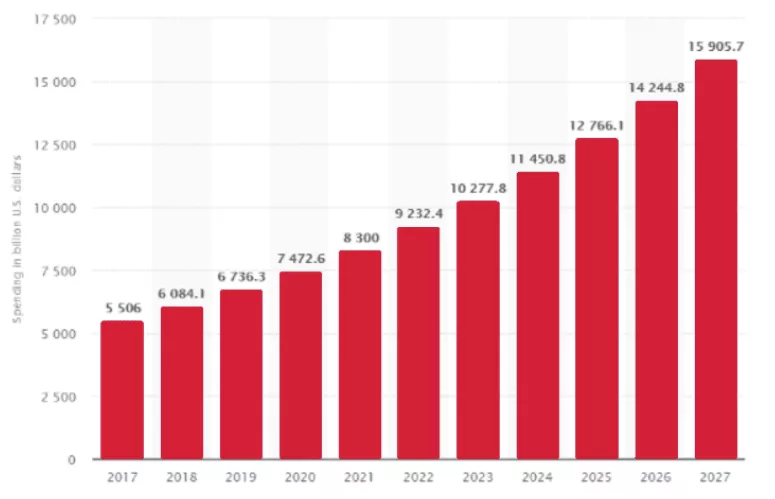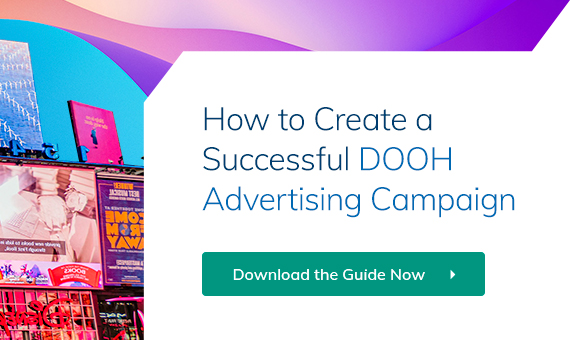How important is it to understand the difference between DOOH networks vs digital signage? We’ll let the figures speak for themselves.
Digital Out of Home ad spending now makes up a significant share of total out of home. After the obvious dip in 2020, digital ad space constitutes 31.2% of total OOH spend in 2021, according to eMarketer.
This is a combination of regulars returning to the arena (51% of the top OOH advertisers more than doubled their OOH spend on 2020 levels) and the OOH market becoming ever more accessible to a larger range of brands.
With new buying methods, real-time analytics and hugely enhanced options for audience targeting, smaller businesses can now harness digital out of home media in a way that has been impossible previously.
Meanwhile, recent research by Statista suggests long-term acceleration of the DOOH advertising market until at least 2027:

(Source: statista.com)
In this light, familiarity with key concepts is vital if you want to join the many businesses starting to benefit from DOOH media, next year and beyond.
As with any sort of new venture, understanding how key processes fit together is essential if you want to harness it to maximum benefit. Some of the language used, however, can be confusing to first-timers, making managing your first DOOH campaign seem unnecessarily daunting.
That’s why we’ve put together this explainer blog to cover two of the most common terms: ‘DOOH network’ vs ‘digital signage.’ Below, we’ll go into detail on the meaning of each before establishing their relationship with each other.
What Is Digital Signage?
‘Digital signage’ is an umbrella term that covers all digital screens used to display any sort of content whatsoever. This includes:
- Digital billboards
- Digital street furniture
- Instore signage
- Signage in shopping malls
- Screens on buses, trains, taxis and other methods of transport
- Pitch side advertising in sports stadiums
- Smart kiosks
- Other types of outdoor advertising, such as video walls
By ‘digital screen,’ we mean any display board powered by technologies like LCD, LED or electronic paper to enable instantly updateable, dynamic displays. Unlike traditional OOH media (for example, traditional billboards and light boxes), digital displays can be used to cycle through multiple ads in a small time period.
Digital signage has a myriad of uses. In public, you might have seen it used to:
- Advertise products and services
- Share public health advice (particularly during COVID-19)
- Provide directions/instructions during major events
- Provide directions to local businesses
- Advertise specific deals and offers, in store and externally
What Is a DOOH Network?
Digital out of home (DOOH) advertising is any advertising that is delivered to consumers:
- In a public place (outside of their own home)
- Via digital signage
In other words, DOOH advertising is just one of the range of uses for digital signage we discussed above.
Moving on, then, to DOOH networks: what are they and what are they designed to achieve?
A DOOH network is a collection of digital OOH inventory owned by the same company. Major advertising companies – for example JCDecaux have global networks of public ad space that they rent out to advertisers.
DOOH networks typically include independently addressable pieces of digital signage. In other words, you can choose which screens suit your needs best in terms of location. DOOH networks fall into two main categories:
- Digital place-based networks (DPN)
- Digital billboards and signage (DBB)
The type of network you choose will depend on your goals. Digital place-based networks deliver tailored messaging through digital screens that update with location and context-specific content.
Meanwhile, digital billboards and signage networks offer huge visibility, targeting based on external conditions (such as weather data, footfall and traffic).
How Do You Buy Space on a DOOH Network?
There are two main methods of buying space on DOOH inventory:
- Via a media buying agency
- Via a programmatic exchange
Traditionally, businesses have gone through media buying agencies to secure OOH ad space. The main issue with this process is that it is slow and expensive.
With more small businesses wanting to leverage DOOH advertising, and marketers in general looking for real-time analytics and optimization options, traditional buying methods are increasingly unfit for purpose. Targeting is limited beyond basic location/time options and it’s difficult to obtain reports on campaign performance in real time.
On the other hand, programmatic exchanges automate the buying and selling of space on DOOH advertising networks, much like how you buy online ads. This means that you can specify the conditions under which your ad should be shown and only pay when that space becomes available – you can engage your own target audience whilst reaping all the benefits of a mass marketing tool at the same time.
Because programmatic exchanges facilitate direct transactions between advertisers and media owners, they also enable real-time analytics, so that you can optimize campaigns minute by minute for optimum ROI.
DOOH Networks vs Digital Signage: In Conclusion
It’s not so much a case of establishing a difference between these two terms as establishing their relationship with one another. They are not directly comparable in an ‘either/or’ way – but it is useful to understand how they interconnect.
Digital signage is any sort of digital public display. One of its main uses is for out of home advertising.
A DOOH network is simply a collection of digital screens (‘signage’) owned by a single business.
Different types of digital signage, such as digital billboards and street furniture are the physical building blocks of DOOH networks. They are what media owners sell to advertisers, either via media buying agencies or via programmatic exchanges.
Find the Right Programmatic DOOH Platform For You
To buy space on DOOH advertising networks efficiently whilst being able to set your own conditions for their display, you’ll need to find a good programmatic buying platform. This should be easy to use and connect you with a wide range of inventory.
At The Neuron, we connect advertisers directly with national and global level DOOH networks so you’ve got the tools you need to build brand awareness, increase revenue and run the best campaign you possibly can.
Give your DOOH campaign a boost with real-time performance metrics, single-click processes and easy automated bidding and watch your KPIs go stratospheric.
Find the Buying Platform for Dynamic DOOH Advertising
To run dynamic DOOH campaigns successfully, you’ll need to find a platform that:
- Offers an intuitive user interface that allows real-time updates to your ad creative in an engaging and easy way
- Connects you to a wide range of digital billboards, digital street furniture, digital signage and other inventory
- Collects real-time campaign data for analysis and optimization
The Neuron is a Demand Side programmatic DOOH platform that directly connects advertisers to an extensive range of media owners and their inventory – and premium inventory.
With single-click processes and a range of real-time reports, it opens the dynamic DOOH door to a whole new market of small businesses and agencies.

